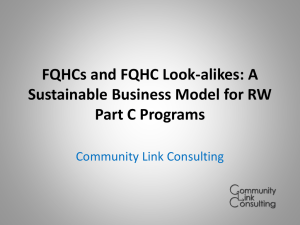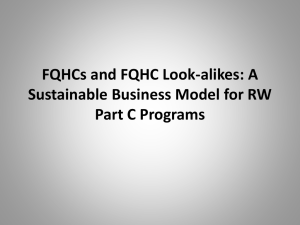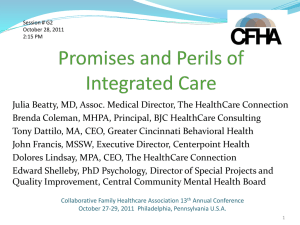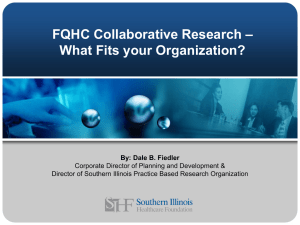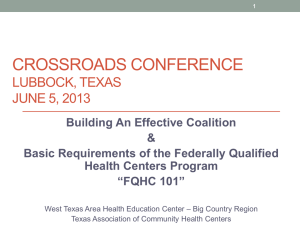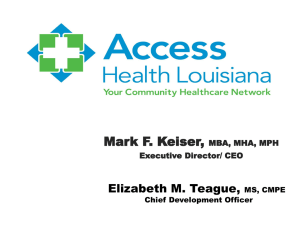Reconciling Section 330 Requirements and Retail Clinic Principles
advertisement
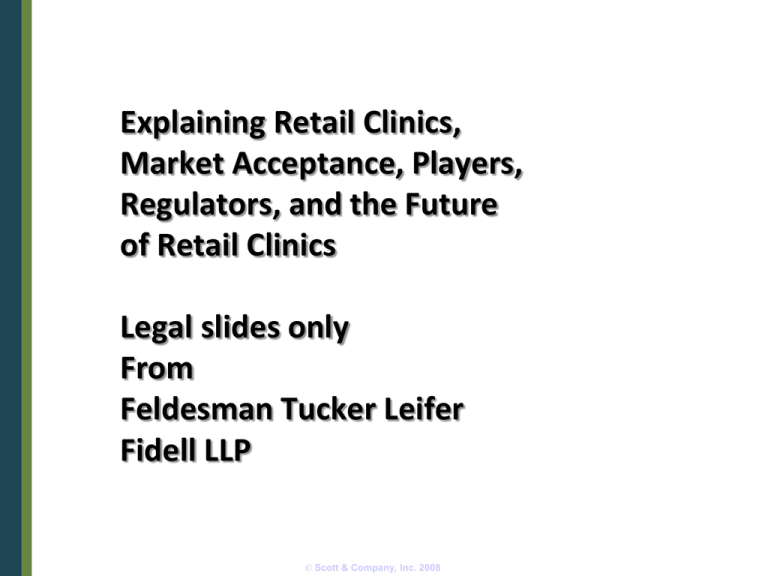
Explaining Retail Clinics, Market Acceptance, Players, Regulators, and the Future of Retail Clinics Legal slides only From Feldesman Tucker Leifer Fidell LLP © Scott & Company, Inc. 2008 Reconciling Section 330 Requirements and Retail Clinic Principles NOTE: FQHCs are advised to consult with knowledgeable local counsel when evaluating and implementing a retail clinic model 1. Patients’ access to the FQHC’s full scope of services • 2. All patients served at the FQHC’s retail clinic site must have reasonable access to the full scope of services offered by the FQHC as a whole Schedule of charges and discounts • Charges: – • Discounts – • Consistent with locally prevailing rates and designed to cover the reasonable costs of operation Adjusted based on ability to pay for uninsured and underinsured persons with annual incomes at and below 200% of the federal poverty level (full discounts/nominal fee for uninsured and underinsured persons with annual incomes at or below 100% of poverty); no discounts to third party payors Must not deny any individual services based on ability to pay © 2009 Reconciling Section 330 Requirements and Retail Clinic Principles 3. Hours of operation • Must be appropriate for the community and facilitate access to services 4. Composition of the Board • If new demographic group represents a significant portion of the FQHC’s patient base, then the FQHC must ensure that the new population is sufficiently represented on its Board 5. Board authorities • Directors should be involved in the process of evaluating and selecting a retail clinic model • Must approve the retail clinic services, hours or operation, and any change in key policies and procedures © 2009 Scope of Project • An FQHC that wishes to establish a retail clinic outside of its existing site(s) must request and obtain prior approval from HRSA to add the new site to its scope of project © 2009 Change of Scope of Project Request • The “change of scope” request must – Document that no additional Section 330 funds are needed to support the provision of services at the new site(s) – Not shift resources away from providing services to the current target population, or otherwise result in the diminution of the FQHC’s total level or quality of health services currently provided to the target population – Further the FQHC’s mission by increasing or maintaining access and improving or maintaining quality of care for the target population – Be fully consistent with Section 330 and Health Center Program Expectations, including appropriate governing board representation for changes in service sites and populations served – Provide for appropriate credentialing/privileging of providers © 2009 Change of Scope Request: Special Retail Clinic Considerations • 2007 HRSA Letter: FQHCs seeking to submit a request to add a retail clinic site (located within a retail institution) to its scope of project should be prepared to answer the following: – What is the FQHC’s plan for providing retail clinic patients with access to primary care services not offered at the retail clinic site? How will the FQHC staff ensure appropriate follow-up and coordination of care? – How will the FQHC ensure that the retail clinic addresses the needs of special populations (e.g., elderly, chronically ill)? – What is the FQHC’s plan for instituting its sliding fee scale at the retail clinic sites? – What role will the retail establishment play in the operation of the retail clinics? Will it pay for the clinic’s overhead costs? Will they have any control of the fee scale, clinical protocols, hours, or the supervision of staff? – What is the business relationship between the FQHC and the retail establishment? © 2009 Securing FQHC Benefits If retail clinic model arrangement is operated within FQHC’s scope of project, the FQHC may enjoy certain Section 330 related benefits –Cost-related –Federal –Drug reimbursement Tort Claims Act (FTCA) coverage pricing under Section 340B –Anti-kickback –Access statute safe harbor to VFC Vaccines © 2009 Securing FQHC Benefits: Cost-Related Reimbursement Access to cost-related reimbursement • – Access to reimbursement under the Prospective Payment System (“PPS”) or other state-approved alternative payment methodology (which is predicated on a cost-based reimbursement methodology) for Medicaid and CHIP services and cost-based reimbursement for services provided under Medicare • “Wraparounds” for difference between Medicaid and CHIP managed care capitation and PPS; wraparound on Medicare managed care payments effective FY 2006 and on CHIP payments effective FY 2010 © 2009 Securing FQHC Benefits: Federal Tort Claims Act for Section 330 Grantees • Access to Federal Tort Claims Act ("FTCA") coverage, in lieu of purchasing malpractice insurance, may significantly reduce the costs of operating a retail clinic – FTCA is only available for: • the deemed FQHC (as well as its directors and officers); • FQHC employees that provide services on a full-time or part-time basis; • individually contracted providers who furnish services in the fields of general internal medicine, family practice, general pediatrics and obstetrics and gynecology, regardless of the number of hours worked; and • individually contracted providers who furnish services in other fields of practice, so long as they provide such services to FQHC patients for an annual average of 32 ½ hours a week (i.e., on a full time basis). – With certain exceptions, FTCA only covers services provided within the FQHC’s approved “scope of project” and within the provider’s scope of employment/contract • If a provider at a retail clinic site is not covered under FTCA, the FQHC must ensure that he/she secures and maintains policies of professional liability (malpractice, errors and omissions) insurance and/or self-insurance © 2009 Securing FQHC Benefits: Section 340B Drug Pricing • Access to favorable drug pricing under Section 340B of the Public Health Service Act – FQHC cannot supply 340B drugs to individuals who are not registered FQHC “patients” – Individual will not be considered a “patient” for 340B purposes if the only health care service received from the FQHC is the dispensing of a drug or drugs for subsequent self-administration or administration in the home • FQHC that locates a site in or near to a retail store that operates a pharmacy will need to consider the implications of such arrangement for its current pharmacy operations (whether FQHC-owned or contracted) © 2009 Securing FQHC Benefits: Anti-Kickback Safe Harbor for Section 330 Grantees • Access to the FQHC Health Center Safe Harbor under Federal Anti-Kickback statute: final OIG rule issued October 4, 2007 (42 C.F.R. 1001.952(w)) – Purpose: protect from prosecution under the federal anti-kickback law – Certain arrangements between FQHC Section 330 grantees and providers/suppliers of goods, items, services, donations and loans • That contribute to the FQHC’s ability to maintain or increase the availability, or enhance the quality, of services provided • To the FQHC’s medically underserved patients • If structured properly, may allow for reduced rent, free medical equipment and/or funding to support the establishment of the FQHC’s retail clinic NOTE: See OIG Advisory 01-9 (favorable opinion re: a hospital’s award of community benefit grant to an FQHC that acquired the hospital’s ambulatory care site) © 2009 Securing FQHC Benefits: Vaccines for Children Program • Access to the Federal Vaccine For Children program – VFC vaccines may only be administered to VFC-eligible children • Any child 18 years of age or younger that meets at least one of the following criteria: – Medicaid enrolled (includes children in an expansion CHIP) – Uninsured (does not include children enrolled in a separate CHIP) – American Indian or Alaskan Native (as defined by the Indian Health Services Act) – Underinsured (a child whose health insurance benefit plan does not include VFC vaccinations) » NOTE: Underinsured children are only eligible to receive VFC vaccines through a FQHC or RHC © 2009

